Axolotls are a species of salamander found only in a small region of Mexico near Mexico City. This species is a popular and unusual pet that is very easy to care for. They can live in an aquarium without land, and have an amazing ability to regenerate their limbs. This has made them common laboratory animals for studies on tissue growth.
Sadly, axolotls are critically endangered in the wild due to habitat loss and pollution. But, they are widely bred in captivity because of their use as pets. It is estimated there are now over 20 different types of Axolotl colors kept as pets.
Breeding has led to the development of many different color morphs, some of which are rarer and more desirable. Continue reading for a list of the top 15 morphs and their colors!
Types of Axolotl
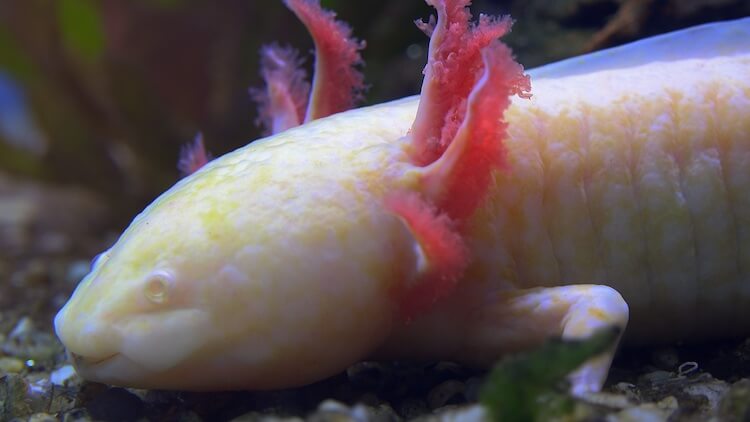
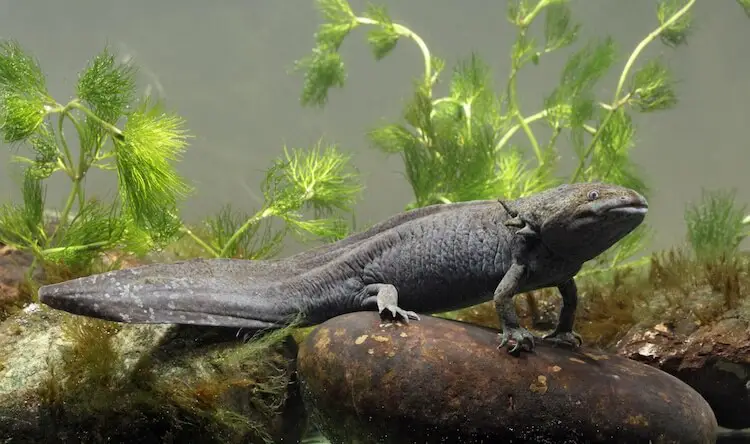
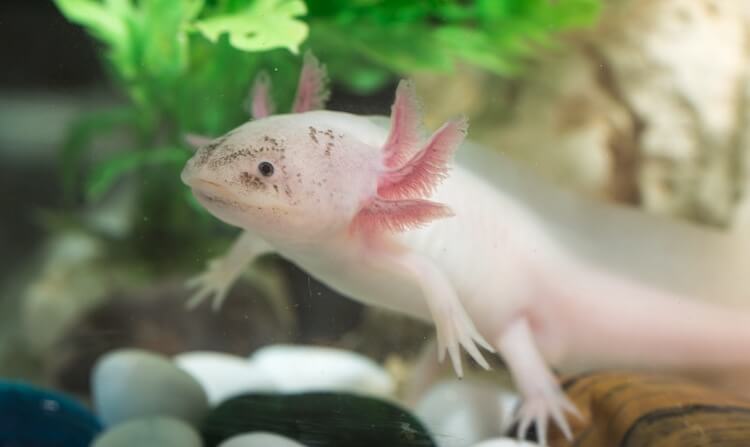
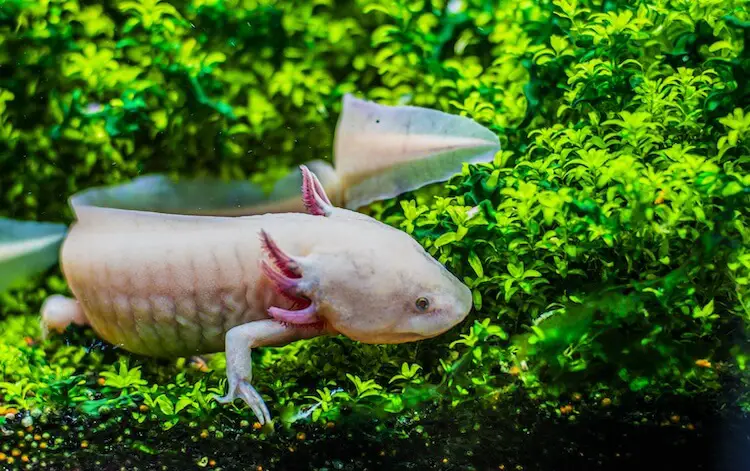
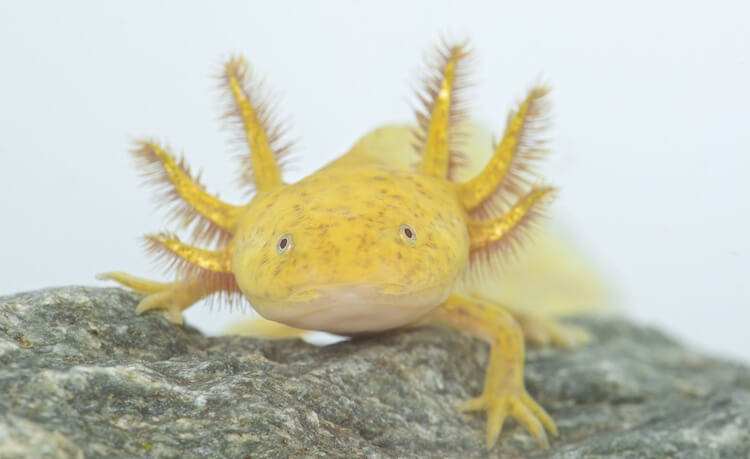
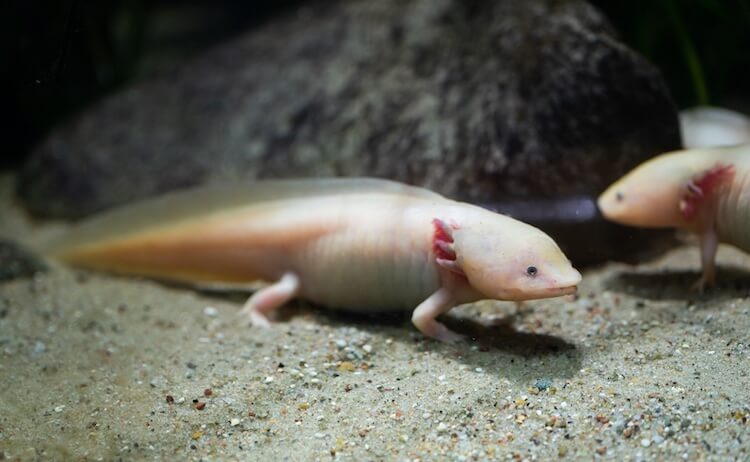
The Mexican axolotl (Ambystoma mexicanum) is a single species that does not have any subspecies. But, the variety of axolotl colors can make it hard to believe that they are just one species. There are now over 20 different colors. Depending on the coloration they can be purchased for anywhere from $40 to $1,500:
| Color / Type | Availability | Price | Rank |
|---|---|---|---|
| Black Melanoid | Common | $65 | 8 |
| Chimera | Very Rare | Not Sold | 11 |
| Enigma | Rare | $1500 | 15 |
| Copper | Uncommon | $100 | 6 |
| Firefly | Rare | $250 | 14 |
| Golden Albino | Common | $50 | 2 |
| Green Fluorescent Protein | Uncommon | $55 | 13 |
| Heavily-Marked Melanoid | Uncommon | $75 | 12 |
| Lavender | Rare | $115 | 7 |
| Leucistic | Common | $45 | 1 |
| Mosaic | Very Rare | Not Sold | 5 |
| Piebald | Rare | $300 | 4 |
| Speckled Leucistic | Common | $50 | 10 |
| White Albino | Common | $40 | 9 |
| Wild | Common | $40 | 3 |
Axolotl Morphs Explained
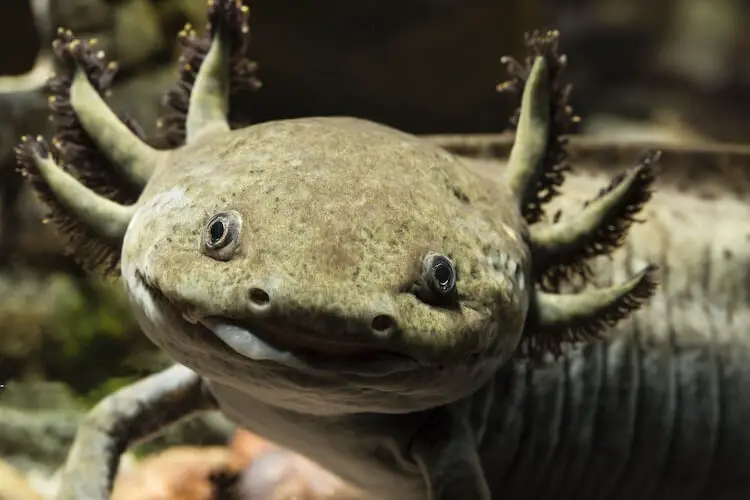
To understand the different colors, we first need to learn about genetics, genes and cells. Axolotls have three different kinds of pigment cells or “chromatophores” that each produces a different color.
| Cell Type | Pigment | Color |
|---|---|---|
| Melanophore | Eumelanin | Blackish-brown |
| Xanthophore | Carotenoids and Pteridines | Yellow and red |
| Iridophore | Crystalized Purines | Shiny, reflective iridescence |
Axolotls inherit their color through two separate genes, one gene comes from each parent.
Each gene has three sections that code for the three types of chromatophores (see table above). These sections are called alleles. The combination of alleles either increase or decrease how many of each chromatophore type is produced in the axolotl’s skin, and this affects its color.
For example, the alleles of an albino individual code for very low levels of melanophores in the skin. Melanophores produce a blackish-brown skin color so in this individual they lack this color and are a distinctive white.
Another example is the black axolotl. Melanoid axolotls have alleles that produce more melanophores that results in a black species.
Some color patterns only appear if an axolotl inherits two of the same alleles from its parents.
An axolotl with one albino allele and one normal allele will not be albino. It needs two copies of the albino allele in order to show the albino coloration. This can make breeding for specific colors much trickier than others and impacts how rare certain morphs can be.
Many morphs begin with a mutation in the normal color alleles, resulting in an unusual color or pattern. This also happens in snakes and a good example are the Ball Python Morphs. Creating a color morph from one mutant individual takes careful selective breeding and lots of patience.
New morphs are still being discovered today as the keeping and breeding of this pet grows in popularity.
Best 15 Axolotl Colors
Looking to adopt an axolotl but don’t know which color or morph to pick? See below for an overview of the top 15 morphs, including genetics, history, pricing and more.
1. Leucistic

Leucistic axolotls are a translucent white with shiny gold flecks, red or pink gills, and dark brown or black eyes. They are very rare in the wild because they are easily spotted by predators, but are one of the most common and beautiful morphs in captivity.
This species looks very similar to albinos, but albinos have red eyes.
Leucism is caused by a mutation that results in fewer melanocytes being produced in the skin. Because melanocytes produce melanin, a dark pigment, axolotls with this mutation do not have the same patterns as the wild-type morph.
2. Golden Albino

Golden albinos range from almost pure white to peach, yellow and orange-gold. They have reflective spots and speckles on their bodies, with white, yellow, or pink eyes. They also have peachy gills with a lighter yellow tint.
As juveniles, they are indistinguishable from white albinos, and also share how they are sensitive to bright lights. It is only as they age that they begin to get their beautiful golden hue.
Like most of the light-colored axolotls in this list, the golden albino morph does not have melanophores.
What makes this morph unique is that it retains xanthophores, which gives it a golden-yellow color. Individuals that additionally have lots of iridophores can look like they are covered in gold leaf.
3. Wild Type
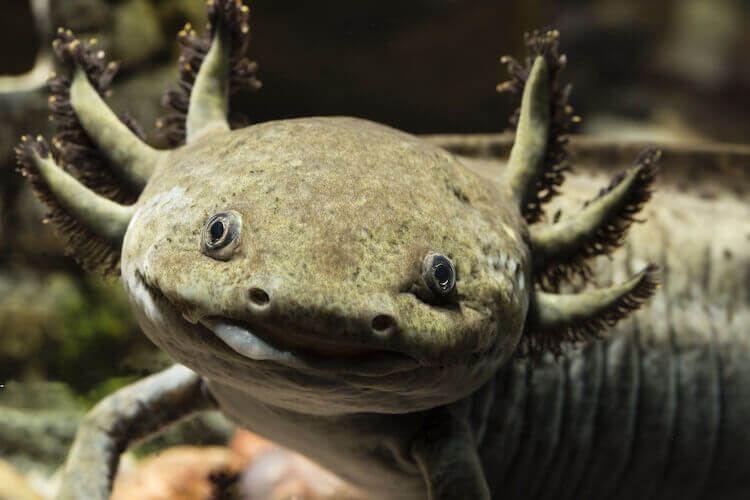
Wild type axolotls are dark grayish green with black and olive mottling. They also have speckles of gold from the iridophores, and a pale belly. They have the same colors and patterns as species found in the wild.
This is the default color and is the oldest in the pet trade. The first wild type species were taken to Europe in 1863.
Depending on the individual, wild axolotls may be nearly black, gray, or a lighter yellow-green. This morph has purple gill filaments and dark eyes with golden irises. Their coloration allows them to blend into the muddy lakebeds near Mexico City.
4. Piebald
Piebalds are white with red gills, black eyes, and dark green, gray, or black symmetrical patches on their face and back. Sometimes, these markings will continue onto their sides and legs, but this is rare. Mostly this pattern is isolated to the top half of the body.
The piebald gene is heritable but very rare, and most breeders are located in New Zealand. This pattern darkens as the axolotl ages and can lead to a black and white salamander.
This species is a type of leucistic morph with a concentration of melanophores on their heads and backs. This is a result of the movement of certain cells during early development in the egg and is called neural crest cells.
5. Mosaic
Mosaic axolotls are mottled with black, white, and golden flecks. They may also have gills that are striped red and purple, and multicolored eyes. Most mosaics are a combination of melanistic and albino parents.
They are the result of two eggs fusing into one. Instead of being split down the middle, each cell displays colors from either parent randomly. This results in a beautiful and one-of-a-kind axolotl color.
Mosaics cannot be bred for and are happy accidents. They are rare and not usually sold, though they may be available on occasion.
6. Copper
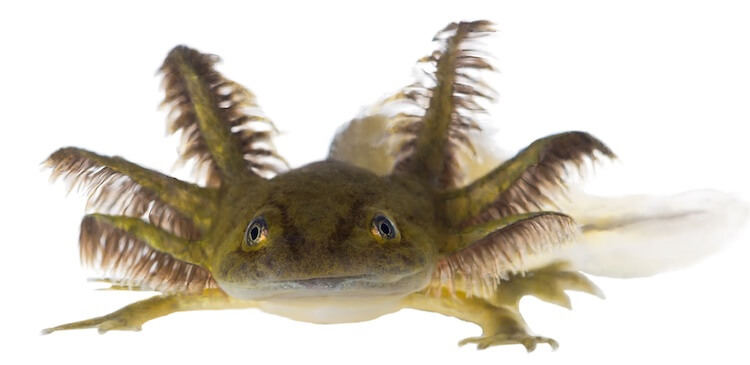
Copper colored axolotls have a light gray body with copper-colored freckles and gray irises. They also have grayish-red gills and a lighter belly. Some copper axolotls are more caramel in color and others are almost pink.
Their cute, speckled faces and sandy colors make this morph popular in areas where they are sold. The first lines of copper axolotls originated in the U.S. and Australia. They are harder to find in other countries.
The copper morph is a less-extreme example of albinism. They have reduced levels of melanin and pteridines, but these pigments are not completely absent. Coppers can be bred with other morphs, resulting in specific varieties like melanoid and axanthic copper.
7. Lavender
The lavender axolotl has a light, silvery purple hue with grayish-red gills and black eyes. Their body is also covered in gray spots, giving them their silver Dalmatian name!
Some lavender species can take on a gray or green color as they age, but most remain purple. Lavender melanoid hybrids are also bred and have a darker purple color with no spots. However, this color combination is very rare.
Lavender morphs have only been bred a few times and are found mainly in the United States. Its soft purple color and polka-dotted appearance make them highly desirable, despite their rarity.
8. Black Melanoid

This recessive mutation was first found in 1961 in a laboratory and is now fairly common. Black Melanoids are the opposite of albinos. Melanoid species have more melanophores and fewer iridophores
They can range from a dark green to a completely black color with dark purple gills. Most melanoids also have a paler grey or purple belly. Some individuals look similar to a dark wild-type, but will lack the shiny golden iris seen in wild axolotls.
Black melanoids are able to change their color tones depending on the substrate. This color change is not permanent, and your axolotl will change with any substrate:
- A light substrate like white sand will cause your axolotl to lighten up.
- A dark substrate will result in a dark black individual.
9. White Albino

White albinos are pure white with red gill filaments, pink or white eyes, and golden flecks on the gill stalks. Young white albinos may even be almost see-through, especially on their belly. As they grow, the iridophores on their gills become a deeper red and the rest of the body stays pure white.
This species has a lack xanthophores and melanophores. They do have iridophores, but these cells are confined solely to the gills.
White albinos are very similar to leucistic axolotls, but they do not have pigment in their eyes. Because of this, white albinos are more sensitive to light and generally have poorer vision than other types of axolotl.
10. Speckled Leucistic

Speckled leucistic axolotls are a type of leucistic mutation. They have dark green, brown, or black speckles on their heads, tails, and back. Like normal leucistic morphs, their base color is white, and the amount of speckling is not as extreme as it is in the piebald or mosaic morphs.
This axolotl often starts out looking identical to a leucistic and develops speckling later in life. As they grow their pigment cells mature too, allowing their coloration and freckle pattern to change.
11. Chimera
The Chimera is so rare that there is debate about whether or not it should be classified as a true morph. Chimeras show one morph on one side of their body and another morph on the other half. It is split right down the middle into left and right halves. The few chimeras that have hatched are half albino and half wild-type.
Chimera axolotls only occur when two developing eggs fuse together into one. Most do not hatch because the two eggs did not fuse completely.
Because Chimeras are a developmental accident, and are not caused by genetics, they cannot be selectively bred.
12. Heavily-Marked Melanoid
Heavily-Marked melanoids are a unique variation of the black melanoid morph.
They have the same black and purplish-gray spots of normal black melanoids, but they have light green and yellow patches too. Very little is known about this morph and it has only been seen a few times. These color morphs are rare because there is no way to predict whether two melanoid parents will produce heavily-marked offspring.
13. Green Fluorescent Protein
Green Fluorescent Protein axolotls look like any morph at first glance. However, once exposed to UV light, they glow a bright fluorescent green. This trait is invisible in normal lighting but is unmistakable in UV light. Those with lighter skin glow brighter, as in albino or leucistic.
The green fluorescent protein gene is originally found in jellyfish and was introduced into the axolotl genome artificially. This morph was created by researchers at the Max Planck Institute in 2005 to study cellular movement and cancer.
14. Firefly
Firefly axolotls are an artificially created morph developed by Lloyd Strohl. Embryonic graphing was originally used to study limb regeneration, and there is controversy about using this method to create pets.
The firefly trait must be created in a lab making them very rare.
They are darkly colored wild-type axolotls with green fluorescent protein albino tails. They are called “fireflies” because only part of the body will glow under a blacklight. A wild-type with an albino tail will glow bright green on only the tail, just like a firefly.
15. Enigma
The Enigma morph is dark gray with a white belly and toes, pale red gills, and golden eyes. It is covered in shiny golden patches that appear green from certain angles.
This one-of-a-kind axolotl was first discovered by a breeder in the United States. It is a wild type axolotl with a high number of iridophores.
Currently, there is only one enigma and not much is known about its genetics or the heritability of the morph.

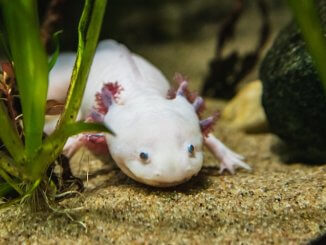
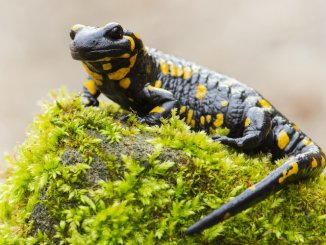

cutee
They are adorble!
AXOLOTLS ARE THE CUTEST AND THE BEST!!!!!!